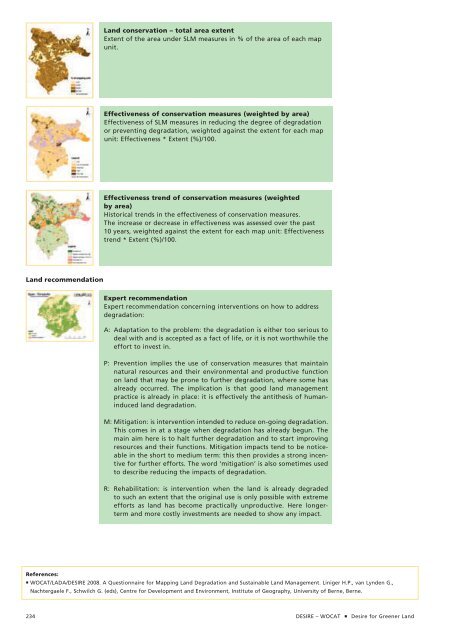Desire for Greener Land
Desire for Greener Land
Desire for Greener Land
You also want an ePaper? Increase the reach of your titles
YUMPU automatically turns print PDFs into web optimized ePapers that Google loves.
<strong>Land</strong> recommendation<br />
<strong>Land</strong> conservation – total area extent<br />
Extent of the area under SLM measures in % of the area of each map<br />
unit.<br />
Effectiveness of conservation measures (weighted by area)<br />
Effectiveness of SLM measures in reducing the degree of degradation<br />
or preventing degradation, weighted against the extent <strong>for</strong> each map<br />
unit: Effectiveness * Extent (%)/100.<br />
Effectiveness trend of conservation measures (weighted<br />
by area)<br />
Historical trends in the effectiveness of conservation measures.<br />
The increase or decrease in effectiveness was assessed over the past<br />
10 years, weighted against the extent <strong>for</strong> each map unit: Effectiveness<br />
trend * Extent (%)/100.<br />
Expert recommendation<br />
Expert recommendation concerning interventions on how to address<br />
degradation:<br />
A: Adaptation to the problem: the degradation is either too serious to<br />
deal with and is accepted as a fact of life, or it is not worthwhile the<br />
ef<strong>for</strong>t to invest in.<br />
P: Prevention implies the use of conservation measures that maintain<br />
natural resources and their environmental and productive function<br />
on land that may be prone to further degradation, where some has<br />
already occurred. The implication is that good land management<br />
practice is already in place: it is effectively the antithesis of humaninduced<br />
land degradation.<br />
M: Mitigation: is intervention intended to reduce on-going degradation.<br />
This comes in at a stage when degradation has already begun. The<br />
main aim here is to halt further degradation and to start improving<br />
resources and their functions. Mitigation impacts tend to be noticeable<br />
in the short to medium term: this then provides a strong incentive<br />
<strong>for</strong> further ef<strong>for</strong>ts. The word ‘mitigation’ is also sometimes used<br />
to describe reducing the impacts of degradation.<br />
R: Rehabilitation: is intervention when the land is already degraded<br />
to such an extent that the original use is only possible with extreme<br />
ef<strong>for</strong>ts as land has become practically unproductive. Here longerterm<br />
and more costly investments are needed to show any impact.<br />
References:<br />
n WOCAT/LADA/DESIRE 2008. A Questionnaire <strong>for</strong> Mapping <strong>Land</strong> Degradation and Sustainable <strong>Land</strong> Management. Liniger H.P., van Lynden G.,<br />
Nachtergaele F., Schwilch G. (eds), Centre <strong>for</strong> Development and Environment, Institute of Geography, University of Berne, Berne.<br />
234 DESIRE – WOCAT <strong>Desire</strong> <strong>for</strong> <strong>Greener</strong> <strong>Land</strong>









